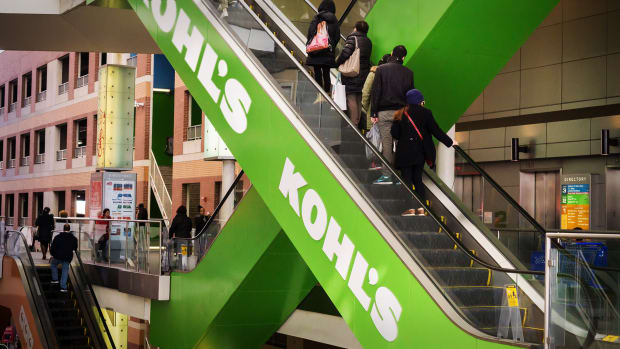
It was 2011 and Kohl’s Corporation (KSS) scored a major coup.
The department store chain inked deals with megastar Jennifer Lopez and singer Marc Anthony for the then married couple to design exclusive clothing and accessories.
Kohl’s, based in Menomomee Falls, Wisconsin, was not really known for its fashion bonafides but the company had a knack for trying new things. Inside stores, the retailer installed kiosks where consumers can browse and shop from Kohl’s website. Kohl’s also allowed people to return merchandise they bought on Amazon to its stores.
DON'T MISS: Starbucks May Have Finally Found the Perfect Cold Foam
And the retailer was performing well, giving it the necessary clout to sign J.Lo.
Unfortunately, the deal marked the high water point for Kohl’s, whose innovative swagger, not to mention margins and market share, has been in steady decline over the years.
(It also didn’t help that J.Lo and Anthony eventually divorced or that Kohl’s decided to launch the collections on the tenth anniversary of the 9/11 terror attacks. You really can’t make this stuff up.)
“Kohl’s started to lose its way a long time ago,” said DeAnn Campbell, chief strategy officer for Hoobil8 consulting firm. The company has been stuck in a prolonged state of “stagflation,” she said.

Image source: Shutterstock
Kohl's Makes a Big Bet On Beauty
To break out of its irrelevance, Kohl’s is betting big on beauty. How big? $1 billion big. The company has been aggressively building Sephora stores inside its department stores, hoping the beauty retailer’s popularity will rub off.
Last year, the retailer spent a whopping $800 million in capital investments building 400 Sephora shops inside Kohl’s locations. Kohl’s will likely spend another $200 million on another 300 locations, including 50 smaller format shops.
On the surface, Kohl’s strategy is smart. The beauty category has performed well for retailers across the spectrum of late, whether we’re talking about the “prestige” market (department stores, specialty shops) or the mass market (pharmacies, supermarkets, dollar stores).
Last year, the beauty market totaled nearly $60 billion, a solid 9% increase in dollar sales from 2021, according to Circana. And most of that increase came from the prestige market, the market research firm said.
For the first quarter of this year, prestige beauty sales jumped 16% to $6.6 billion compared to the same period a year ago. Products like skincare, makeup, and fragrances have performed particularly well.
“We believe Kohl's will benefit from its partnerships,” according to a S&P credit ratings report. “We believe this initiative has good prospects given the favorable market trends in beauty products and Sephora's strong market position.”
For its part, Kohl’s expects a “significant return on investment with an expected payback period of 3.5 years,” according to the company’s most recent investors presentation. The retailer projects the Sephora stores will generate $2 billion in revenue by 2025.
But the real test of the Sephora shops is whether they help prompt more consumers to buy more things at Kohl’s.
Kohl's May Have Made a Mistake
So far, the signs are not good, said Campbell, who has studied the shops.
First of all, the Sephora shops are located too close to the entrance, she said. Ideally, consumers should have to spend time walking through Kohl’s before they get to the Sephora shop so as to increase the chances they see and buy something they like in the department store. By locating the Sephora shop near the entrance/exit, a shopper can visit the Sephora shop without having spent any time in Kohl’s.
Secondly, from a design and merchandising viewpoint, Kohl’s apparently made no effort to blend or integrate Sephora with the department store. This completely defeats the purpose of the shop-within-a-shop strategy, she said.
“The Sephora experience is completely cut off from the Kohl’s experience,” Campbell said. “You forget you’re in a Kohl’s. The shop is just a box inside of the store with Sephora stuff.”
So Kohl’s essentially just acts as a landlord to Sephora, she said.
This mostly benefits Sephora in terms of location. The vast majority of Sephora stores are located in indoor malls, where traffic has been declining. However, about 95% of Kohl’s 1,100 stores are in highly prized “off-mall” locations like lifestyle centers and suburban strip malls.
So Sephora’s deal with Kohl’s allows Sephora the benefit of the off mall location without having to significantly make any changes to its design and brand identity, which is considerably more upscale than the Kohl’s shopper, Campbell said.
That’s too bad because Kohl’s really needs something good to happen. In its report, S&P downgraded Kohl’s credit rating because of the slowing economy and the company’s execution woes.
“We believe department stores continue to face mounting competitive pressures and ongoing execution risk to maintain market share,” the report said. “Declining physical store traffic, shifting category preferences, and online price transparency are persistent longer-term risks for Kohl's business."







